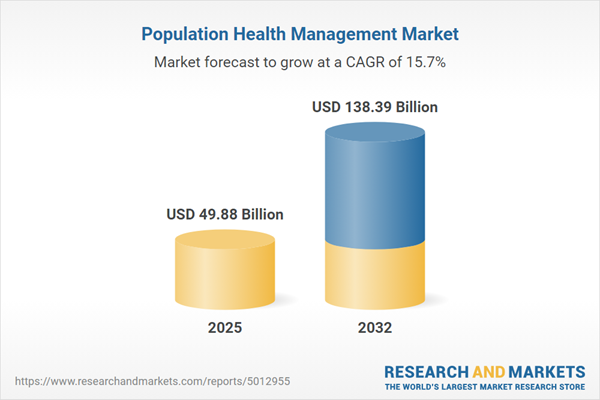Speak directly to the analyst to clarify any post sales queries you may have.
Senior healthcare executives face increasing complexity from evolving care models and regulatory shifts. The Population Health Management Market report provides actionable insights for organizations navigating this transformation, supporting strategic decisions in a digitally driven, value-based landscape.
Market Snapshot: Population Health Management Market Overview
The Population Health Management Market grew from USD 42.97 billion in 2024 to USD 49.88 billion in 2025. It is expected to continue growing at a CAGR of 15.74%, reaching USD 138.39 billion by 2032. Market expansion is fueled by the integration of data analytics, regulatory changes, and increased adoption of digital health technologies. As stakeholders shift away from fee-for-service toward value-based care, the need for interoperable solutions, risk stratification tools, and collaborative care platforms is rising across global healthcare systems.
Scope & Segmentation of the Population Health Management Market
This analysis delivers a comprehensive view of the market’s structure, enabling leaders to benchmark investments and strategy.
- Component – Services (professional, managed), software for analytics, data integration, and patient engagement
- End User – Employers, payers, pharmacies, providers
- Deployment Mode – Cloud (hybrid, public, private) and on-premise
- Application – Care coordination (digital, telephonic), care management (behavioral health, chronic disease, maternity), analytics (descriptive, predictive, prescriptive), risk adjustment (chart review, coding, modeling), and wellness prevention (fitness tracking, coaching, nutritional programs)
- Region – Americas (United States, Canada, Mexico, Brazil, Argentina, Chile, Colombia, Peru), Europe (UK, Germany, France, Russia, Italy, Spain, Netherlands, Sweden, Poland, Switzerland), Middle East & Africa (UAE, Saudi Arabia, Qatar, Turkey, Israel, South Africa, Nigeria, Egypt, Kenya), Asia-Pacific (China, India, Japan, Australia, South Korea, Indonesia, Thailand, Malaysia, Singapore, Taiwan)
- Key Players – UnitedHealth Group, Oracle, Allscripts, Koninklijke Philips, McKesson, Inovalon, Health Catalyst, Evolent Health, Cognizant, IBM
Key Takeaways for Senior Decision-Makers
- The population health management market is experiencing robust investment in advanced analytics and digital integration, primarily driven by regulatory incentives and the push for value-based care models.
- Technology adoption is enhanced by growing interoperability and real-time data integration, enabling earlier intervention in chronic disease management and more effective resource allocation.
- End users, such as employers and providers, leverage tailored solutions to manage risk, improve care coordination, and address social determinants of health, resulting in better outcomes and operational efficiency.
- Regional growth trends highlight the role of regulatory frameworks and market maturity—quick adoption seen in North America and Western Europe, with accelerated investments underway in Asia-Pacific due to rising healthcare expenditures.
- The competitive landscape encourages both technology partnerships and in-house innovations, giving organizations flexibility to adapt to evolving patient and payer needs.
Tariff Impact: Navigating Supply Chain and Cost Challenges
The introduction of tariffs on medical devices, software, and healthcare technology components in 2025 is reshaping procurement strategies. Supply chain teams must navigate cost increases on both hardware and software. Healthcare organizations are responding by exploring domestic production partnerships and diversifying supplier bases. This has accelerated trends toward open-source platforms and cloud subscription models, providing adaptability and cost controls amid shifting trade regulations.
Methodology & Data Sources
The study integrates qualitative insights from decision-maker interviews with systematic secondary analysis, including reviews of industry publications and regulatory documents. Data triangulation and advanced analytical methods ensure credible, multidimensional market perspectives tailored to population health management.
Why This Report Matters
- Enables leaders to identify optimal technology investments and prioritize solutions that meet evolving regulatory and patient demands.
- Delivers actionable intelligence on regional adoption trends, cost pressures, and technology strategies for competitive positioning.
- Supports informed decision-making through credible, data-backed analyses of vendors, deployment models, and application domains.
Conclusion
Strategic alignment in data integration, technology adoption, and stakeholder collaboration is key to success in population health management. Informed decision-making positions organizations to drive quality, manage costs, and achieve lasting improvements as the market continues its dynamic evolution.
Additional Product Information:
- Purchase of this report includes 1 year online access with quarterly updates.
- This report can be updated on request. Please contact our Customer Experience team using the Ask a Question widget on our website.
Table of Contents
3. Executive Summary
4. Market Overview
7. Cumulative Impact of Artificial Intelligence 2025
Companies Mentioned
The companies profiled in this Population Health Management market report include:- UnitedHealth Group Incorporated
- Oracle Corporation
- Allscripts Healthcare, LLC
- Koninklijke Philips N.V.
- McKesson Corporation
- Inovalon Holdings, Inc.
- Health Catalyst, Inc.
- Evolent Health, Inc.
- Cognizant Technology Solutions Corporation
- International Business Machines Corporation
Table Information
| Report Attribute | Details |
|---|---|
| No. of Pages | 193 |
| Published | October 2025 |
| Forecast Period | 2025 - 2032 |
| Estimated Market Value ( USD | $ 49.88 Billion |
| Forecasted Market Value ( USD | $ 138.39 Billion |
| Compound Annual Growth Rate | 15.7% |
| Regions Covered | Global |
| No. of Companies Mentioned | 11 |









